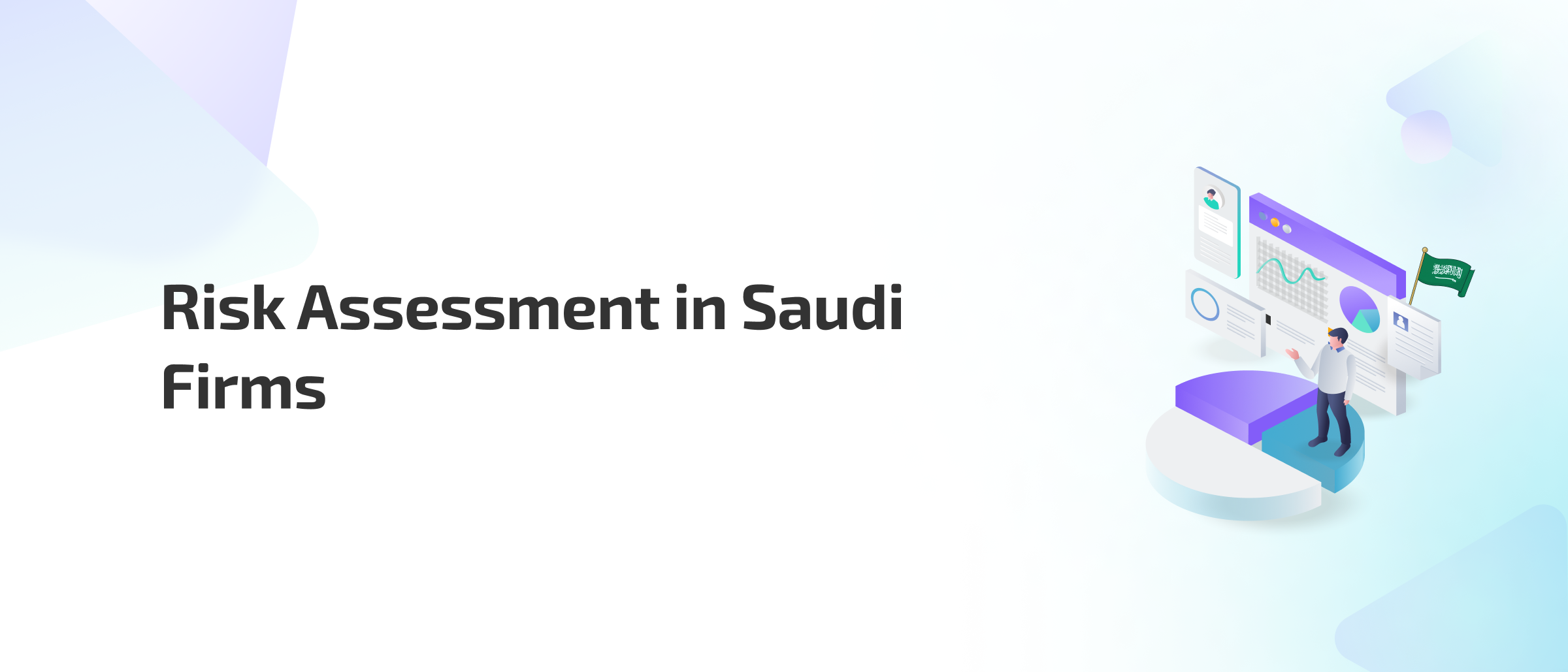.webp)
Published on
August 3, 2025
Risk Assessment in Saudi Arabia: Sector-Specific Risks & Regulation
In this story

Accelerate AML Compliance: Meet Regulatory Demands with 80% Less Setup Time
.svg)
.svg)
Financial crime risks in Saudi Arabia are constantly changing. To stay ahead, institutions must regularly evaluate where their vulnerabilities lie. Effective risk assessment provides a clear picture of threats and helps prioritize actions, keeping businesses safe and compliant with Saudi Central Bank standards.
What Is Risk Assessment in AML and Fraud Prevention?
In Saudi Arabia’s financial ecosystem, risk assessment refers to a structured process of identifying, evaluating, and mitigating risks associated with money laundering, terrorism financing, and financial fraud.
Risk assessment helps banks and financial institutions:
- Detect vulnerabilities in their operations.
- Tailor controls based on risk exposure.
- Allocate resources more efficiently.
- Stay compliant with national and international regulatory frameworks.
The Saudi Central Bank and other supervisory bodies require financial entities to take a risk-based approach to anti-money laundering and counter-terrorism financing programs. This means institutions must assess their own risks based on customer types, products, services, delivery channels, and geographic locations, and respond accordingly.
Why Risk Assessment Matters for Financial Institutions in Saudi Arabia
The financial sector in Saudi Arabia is evolving rapidly with digital transformation, increasing international connectivity, and the ambitious goals of Vision 2030. With that growth comes greater exposure to sophisticated financial crimes.
By conducting a well-designed risk assessment:
- Banks can avoid regulatory penalties and reputational damage.
- Compliance teams can focus on higher-risk customers or activities.
- Institutions can demonstrate compliance to the Saudi Central Bank, auditors, and global partners.
Risk assessment is also the foundation of all anti-money laundering and counter-terrorism financing measures including customer due diligence, transaction monitoring, and internal reporting.
Risk Assessment Under Saudi Arabia’s Vision 2030
Saudi Arabia's Vision 2030 places strong emphasis on enhancing the integrity and transparency of its financial systems. As the Kingdom attracts foreign investment, strengthens financial inclusion, and grows its digital banking sector, robust risk assessment becomes a strategic necessity.
The Saudi Anti-Money Laundering Permanent Committee emphasizes that financial institutions must continuously update their internal understanding of risk in alignment with national priorities and the standards of the Financial Action Task Force (FATF).
Key Takeaway:
Risk assessment is one of the first and most essential layers in building a strong anti-money laundering and counter-terrorism financing framework in Saudi Arabia. It allows financial institutions to detect, prioritize, and respond to risks, and meet national and international compliance expectations.
The Legal and Supervisory Ecosystem Shaping Risk Assessment in Saudi Arabia
Risk assessment practices in Saudi Arabia are governed by a well-defined legal and supervisory framework that aligns with international standards, particularly those established by the Financial Action Task Force (FATF). At the national level, the regulatory landscape is shaped by:
- Saudi Central Bank
- Capital Market Authority (CMA)
- Systemically Important Financial Institutions (SIFIs) Framework
- Central Bank Law (2020)
- Basel Core Principles
- Islamic Financial Services Board (IFSB) Standards
- Anti-Money Laundering Permanent Committee (AMLPC)
- Saudi Arabia Financial Intelligence Unit (SAFIU)
- National Anti-Corruption Commission (NAZAHA)
- Cybersecurity Framework (SAMA CSF)
- National Cybersecurity Authority (NCA)
- Business Continuity Management Framework (BCM)
- Regulatory Sandbox
- Derivatives and Collateral Legal Framework
- Close-out Netting and Bankruptcy Provisions
- OTC Derivatives Margin and Trade Reporting Rules
- Consumer Protection Regulations
1. Role of the Saudi Central Bank and National AML Bodies
The Saudi Central Bank plays a leading role in supervising financial institutions' compliance with anti-money laundering and terrorism financing requirements. Its expectations are detailed and prescriptive. Institutions are required to:
- Implement ongoing risk assessments tailored to their size, complexity, and product offerings.
- Review and update their assessments at least annually, or more frequently when risk factors change.
- Document and justify methodologies, scoring models, and risk classifications used.
2. Alignment with International Standards (FATF Recommendations)
Saudi Arabia, as a member of the Financial Action Task Force (FATF), has committed to following the international standards for anti-money laundering and counter-terrorism financing. These standards require each country to:
- Conduct a national risk assessment.
- Require financial institutions to carry out individualized risk assessments.
- Enforce risk-based supervision by regulatory bodies.
- Maintain systems that are proportionate to identified risks.
The Saudi Central Bank enforces these requirements through regular inspections, thematic reviews, and enforcement actions for institutions found to be non-compliant.
3. Supervisory Trends and Enforcement Actions in Saudi Arabia
Recent years have seen a noticeable shift toward stricter enforcement of anti-money laundering obligations. The Saudi Central Bank has issued several fines and compliance directives to financial institutions that:
- Failed to properly assess customer risk.
- Used outdated or unsupported risk models.
- Lacked evidence of documentation or rationale behind risk classification decisions.
Key Takeaway:
Risk assessment in Saudi Arabia is a legal, regulatory, and supervisory requirement. Financial institutions must align their practices with the Saudi Central Bank’s rules and international FATF standards to remain compliant and competitive.
Comply quickly with local/global regulations with 80% less setup time
.svg)
.svg)
The Five Pillars of Effective Risk Assessment in Saudi Arabia
Risk assessment is a structured, cyclical process that allows financial institutions in Saudi Arabia to anticipate, evaluate, and respond to emerging risks related to money laundering, fraud, and other financial crimes.
Based on both international best practices and the expectations set by the Saudi Central Bank, there are five core steps every institution should follow.
Step One: Identify and Understand Relevant Risks
The first step involves mapping out the key risk areas that may expose the institution to money laundering or other types of financial crimes. These include:
- Customer risk (e.g., politically exposed persons, non-resident clients)
- Product and service risk (e.g., private banking, wire transfers, digital wallets)
- Geographic risk (e.g., jurisdictions under sanctions, high-risk countries)
- Delivery channel risk (e.g., online banking, intermediaries)
Institutions must consider both internal data (such as transaction volumes and customer behaviors) and external data, including the National Risk Assessment issued by the Saudi Anti-Money Laundering Permanent Committee.
Step Two: Analyze and Evaluate the Likelihood and Impact of Each Risk
Once the risks are identified, institutions must assess:
- How likely each risk is to occur
- What the consequences would be if it did
This can be done using qualitative or quantitative scoring models. The Saudi Central Bank encourages financial institutions to use documented, defensible criteria such as assigning scores for high-risk jurisdictions, product categories, or transaction patterns.
A well-designed evaluation should help institutions prioritize which risks deserve more attention and more resources.
Read more: KYC in Saudi Arabia: Regulations, Compliance & Penalties
Step Three: Determine Risk Appetite and Exposure
This step involves aligning the institution’s risk appetite (the amount of risk the institution is willing to accept) with its actual risk exposure. If there is a mismatch (for example, too many high-risk customers with weak controls), adjustments must be made.
This step should result in a risk register or risk heat map that clearly shows the distribution of threats across the institution’s operations.
Step Four: Implement Controls to Mitigate Risks
Mitigation is where institutions put theory into practice. Based on the outcomes of their assessments, they must apply targeted control measures, including:
- Enhanced due diligence for high-risk customers
- Transaction monitoring rules tailored to specific risk patterns
- Stronger onboarding procedures for products and services with higher vulnerability
- Ongoing training for staff based on identified weak points
The Saudi Central Bank expects that these controls will be risk-proportionate, meaning they must match the level of risk identified, not exceed or fall short of it.
Step Five: Monitor, Review, and Update the Risk Assessment
Risk is dynamic and thus financial institutions are expected to:
- Re-assess risks at least once every two years, and after any major business change (e.g., entering a new market, launching a new product)
According to Article (5) of the Anti-Money Laundering Law, Article (63) of the Law on Combating Terrorism Crimes and Financing, and Article (16) of its Implementing Regulations:
“The financial institution shall take the appropriate steps to identify, assess, understand, and document in writing its ML/TF risks, provided that the nature and scope of the risk assessment are commensurate with the nature and size of the financial institution's business. Such risk assessment shall be updated regularly (once every two years at a minimum) and shall be documented and approved by the senior management.”
- Review the effectiveness of controls; are they reducing risk, or are new threats emerging?
- Update risk classification models as needed based on performance, audit findings, and feedback from regulators
Key Takeaway:
Risk assessment is a structured, five-step process: identify, evaluate, align, mitigate, and monitor. When done properly, it enables Saudi financial institutions to stay ahead of threats and build an effective anti-money laundering and terrorism financing framework rooted in strategy — not guesswork.
Sector-Specific Risks in Saudi Arabia
Different financial sectors in Saudi Arabia face different levels and types of risks. The table below summarizes the key risks and expectations for each major sector:
Key Takeaway:
Each financial sector in Saudi Arabia faces unique risks. Knowing where the danger is highest allows institutions to focus their compliance efforts and protect their business.
Common Risk Assessment Mistakes and How to Avoid Them
Even well-intentioned financial institutions can fall short when conducting risk assessments. This section outlines the most common problems, and provides simple, actionable solutions.
Final Thoughts
Success comes from a risk assessment program that is thoughtful, flexible, and well-documented, one that evolves with the landscape and supports clear decision-making. Such a program does not remain static; instead, it evolves continuously in response to changing threats, emerging technologies, and shifts in the regulatory environment.
This approach helps financial institutions in Saudi Arabia stay prepared, protect their operations, and support the country’s financial stability.
Streamline Compliance: Achieve 80% Faster Setup for Fraud Prevention
.svg)
.svg)

How Aseel reduced onboarding time by more than 87% using FOCAL
Learn how FOCAL empowered Aseel to achieve new milestones.
.svg)
.svg)
Mastering Fraud Prevention: A Comprehensive Guide for KSA and MENA Businesses
51% of organizations fell victim to fraud in the last two years, don't be caught off guard, act proactively.
.svg)
.svg)
Featured blog posts
.svg)
AI-Driven Precision in Fraud Risk and AML Compliance
.svg)
.svg)

.svg)
.png)





.png)
.webp)




.svg)

_FastestImplementation_Small-Business_GoLiveTime.png)

_HighPerformer_Small-Business_HighPerformer.png)
_Leader_Leader.png)



%20(1).webp)